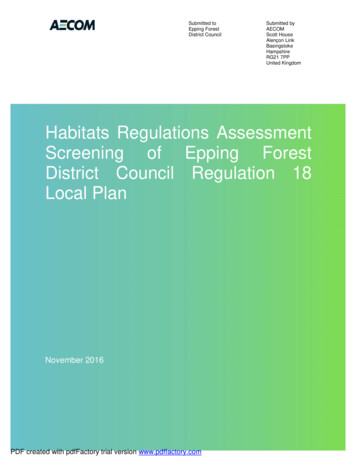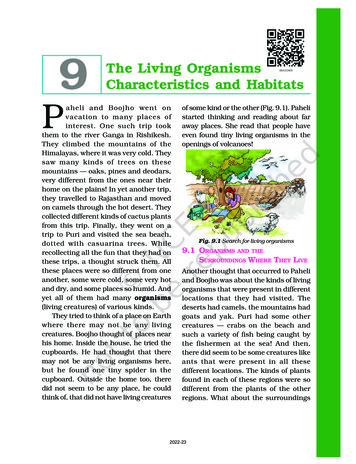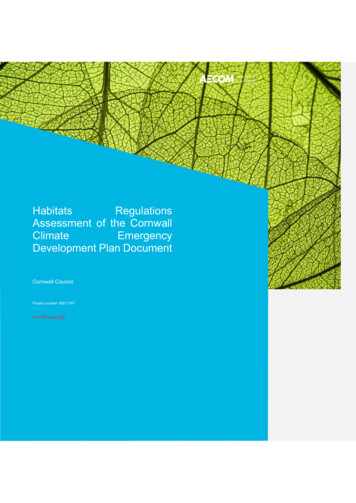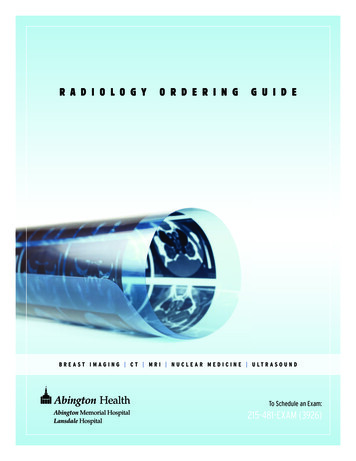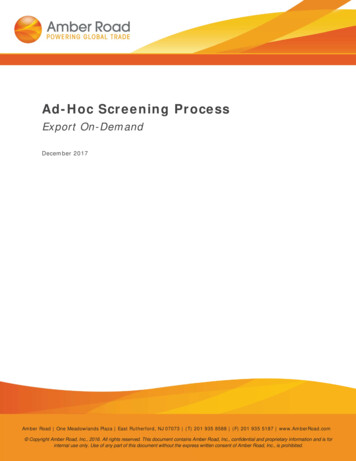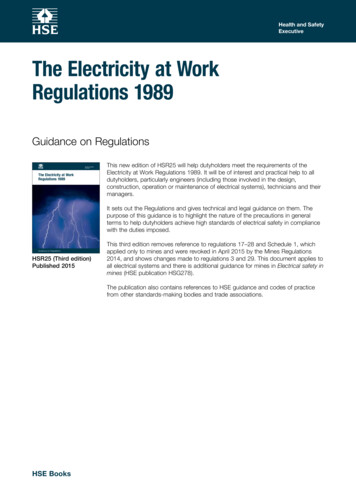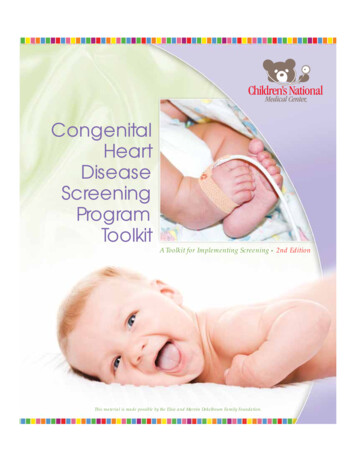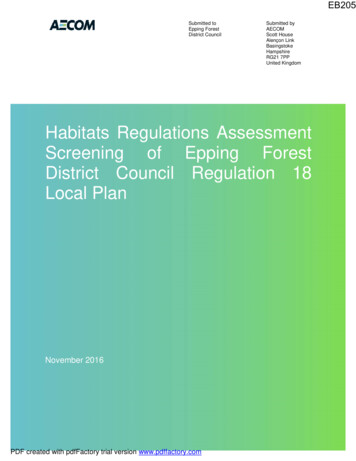
Transcription
EB205Submitted toEpping ForestDistrict CouncilSubmitted byAECOMScott HouseAlençon LinkBasingstokeHampshireRG21 7PPUnited KingdomHabitats Regulations AssessmentScreening of Epping ForestDistrict Council Regulation 18Local PlanNovember 2016PDF created with pdfFactory trial version www.pdffactory.com
EB205AECOMHabitats Regulations Assessment Screening of EppingForest District Council Regulation 18 Local PlanPrepared by:Isla Hoffmann HeapConsultant EcologistApproved by:Max WadeTechnical DirectorRev No0Checked by:CommentsDraft for commentPage iJames RileyAssociate DirectorCheckedbyJRApprovedbyMWDate03/11/16Scott House, Alençon Link, Basingstoke, Hampshire, RG21 7PP, United KingdomTelephone: 01256 310 200 Website: http://www.aecom.comJob No: 60512493Epping Forest District CouncilPDF created with pdfFactory trial version www.pdffactory.comNovember 2016November 2016
EB205AECOMHabitats Regulations Assessment Screening of EppingForest District Council Regulation 18 Local PlanPage iiLimitationsAECOM Infrastructure & Environment UK Limited (“AECOM”) has prepared this Report for the sole use of Epping ForestDistrict Council in accordance with the Agreement under which our services were performed. No other warranty,expressed or implied, is made as to the professional advice included in this Report or any other services provided byAECOM. This Report is confidential and may not be disclosed by the Client nor relied upon by any other party without theprior and express written agreement of AECOM.The conclusions and recommendations contained in this Report are based upon information provided by others and uponthe assumption that all relevant information has been provided by those parties from whom it has been requested and thatsuch information is accurate. Information obtained by AECOM has not been independently verified by AECOM, unlessotherwise stated in the Report.The methodology adopted and the sources of information used by AECOM in providing its services are outlined in thisReport. The work described in this Report was undertaken between August 2016 and November 2016 and is based onthe conditions encountered and the information available during the said period of time. The scope of this Report and theservices are accordingly factually limited by these circumstances.Where assessments of works or costs identified in this Report are made, such assessments are based upon theinformation available at the time and where appropriate are subject to further investigations or information which maybecome available.AECOM disclaim any undertaking or obligation to advise any person of any change in any matter affecting the Report,which may come or be brought to AECOM’s attention after the date of the Report.Certain statements made in the Report that are not historical facts may constitute estimates, projections or other forwardlooking statements and even though they are based on reasonable assumptions as of the date of the Report, suchforward-looking statements by their nature involve risks and uncertainties that could cause actual results to differmaterially from the results predicted. AECOM specifically does not guarantee or warrant any estimate or projectionscontained in this Report.Copyright This Report is the copyright of AECOM Infrastructure & Environment UK Limited. Any unauthorised reproduction orusage by any person other than the addressee is strictly prohibited.Epping Forest District CouncilPDF created with pdfFactory trial version www.pdffactory.comNovember 2016
EB205AECOMHabitats Regulations Assessment Screening of EppingForest District Council Regulation 18 Local PlanPage iiiContents1Introduction . 51.11.21.31.42Methodology. 82.12.22.32.43Introduction . 8HRA Task 1 - Likely Significant Effects (LSE) . 9Principal Other Plans and Projects That May Act ‘In Combination’ . 9Air Quality Impact Assessment . 10Pathways of Impact . 143.13.23.33.43.545Background to the Project . 5Current Legislation . 5Scope of the Project . 6This Report . 7Introduction . 14Disturbance from Recreational Activities and Urbanisation . 14Atmospheric Pollution . 18Water abstraction . 19Water quality. 19Initial Policy Sift . 22Urbanisation . 545.2 Epping Forest SAC . 546Recreational Pressure . 566.2 Lee Valley SPA/Ramsar site. 576.3 Wormley-Hoddesdonpark Woods SAC . 586.4 Epping Forest SAC . 597Air Quality . 637.2 Lee Valley SPA/Ramsar site. 637.3 Epping Forest SAC . 648Water Abstraction . 678.2 Lee Valley SPA/Ramsar site. 679Water Quality . 689.2 Lee Valley SPA/Ramsar site. 6810Summary of Recommendations and Conclusions . 7010.2 Urbanisation . 7010.3 Recreational Pressure . 7010.4 Air Quality . 71List of AppendicesAppendix A. FiguresAppendix B. Background to Internationally Designated SitesAppendix C. Air Quality Impact Assessment: Lee Valley SPA/Ramsar siteAppendix D. Air Quality Impact Assessment: Epping Forest SACEpping Forest District CouncilPDF created with pdfFactory trial version www.pdffactory.comNovember 2016
EB205AECOMHabitats Regulations Assessment Screening of EppingForest District Council Regulation 18 Local PlanPage ivList of TablesTable 1: Housing levels to be delivered across Epping Forest and surrounding authorities, provided for context. . 10Table 2: Location of Road Links analysed within 200m of Epping Forest SAC and Lee Valley SPA/Ramsar site . 12Table 3: Main sources and effects of air pollutants on habitats and species . 18Table 4: Wastewater Treatment Works with Catchments Serving Settlements Identified to Provide New Development inthe Local Plan. . 20Table 5: Screening Assessment of Development Management Policies . 22Table 6: Initial sift of Strategic Site Allocations (including Traveller Site Allocations) . 40Table 7: HMA Transport Flow Data Summary . 64Table 8: Changes to traffic flows as a result of the five SMA Options . 64List of FiguresFigure 1: Four Stage Approach to Habitats Regulations Assessment. Source CLG, 2006. . 8Figure 2: Traffic contribution to concentrations of pollutants at different distances from a road (Source: DfT) . 11Epping Forest District CouncilPDF created with pdfFactory trial version www.pdffactory.comNovember 2016
EB205AECOMHabitats Regulations Assessment Screening of EppingForest District Council Regulation 18 Local Plan1Introduction1.1Background to the ProjectPage 51.1.1AECOM was appointed by Epping Forest District Council to assist the Council in undertaking aHabitat Regulations Screening Assessment of its Regulation 18 Local Plan (hereafter referred to asthe ‘Plan’ or ‘Local Plan’). The objective of this assessment is to identify any aspects of the Plan thatwould cause an adverse effect on the integrity of Natura 2000 sites, otherwise known as Europeansites (Special Areas of Conservation (SACs), Special Protection Areas (SPAs) and, as a matter ofGovernment policy, Ramsar sites), either in isolation or in combination with other plans and projects,and to advise on appropriate policy mechanisms for delivering mitigation where such effects wereidentified.1.1.2An assessment of housing need across the East Herts and West Essex Housing Market Area (HMA)has been conducted, which was then used as the basis for developing the Local Plan. The HMAcovers Epping Forest District Council, Harlow Council, East Herts District Council and UttlesfordDistrict Council. The HMA developed a series of different Options for quanta and distribution ofhousing in each of the Authority boundaries, focussed on growth within the broad Harlow area. Tounderpin this, traffic modelling and an air quality impact assessment regarding impacts on Lee ValleySPA/Ramsar site and Epping Forest SAC was undertaken of each of the Options. Data from thatanalysis is used to inform this HRA.1.2Current Legislation1.2.1The need for Appropriate Assessment is set out within Article 6 of the EC Habitats Directive 1992, andinterpreted into British law by the Conservation of Habitats and Species Regulations 2010. Theultimate aim of the Directive is to “maintain or restore, at favourable conservation status, naturalhabitats and species of wild fauna and flora of Community interest” (Habitats Directive, Article 2(2)).This aim relates to habitats and species, not the European sites themselves, although the sites havea significant role in delivering favourable conservation status.1.2.2The Habitats Directive applies the precautionary principle to European sites. Plans and projects canonly be permitted having ascertained that there will be no adverse effect on the integrity of the site(s)in question. Plans and projects with predicted adverse impacts on European sites may still bepermitted if there are no alternatives to them and there are Imperative Reasons of Overriding PublicInterest (IROPI) as to why they should go ahead. In such cases, compensation would be necessaryto ensure the overall integrity of the site network.1.2.3In order to ascertain whether or not site integrity will be affected, an Appropriate Assessment shouldbe undertaken of the plan or project in question:Epping Forest District CouncilPDF created with pdfFactory trial version www.pdffactory.comNovember 2016
EB205AECOMHabitats Regulations Assessment Screening of EppingForest District Council Regulation 18 Local PlanPage 6Box 1: The legislative basis for Appropriate AssessmentHabitats Directive 1992Article 6 (3) states that:“Any plan or project not directly connected with or necessary to the management of the site butlikely to have a significant effect thereon, either individually or in combination with other plans orprojects, shall be subject to appropriate assessment of its implications for the site in view of thesite's conservation objectives.”Conservation of Habitats and Species Regulations 2010The Regulations state that:“A competent authority, before deciding to give any consent for a plan or project which is likely tohave a significant effect on a European site shall make an appropriate assessment of theimplications for the site in view of that sites conservation objectives The authority shall agree tothe plan or project only after having ascertained that it will not adversely affect the integrity of theEuropean site”.1.2.41.31.3.1Over time the phrase ‘Habitats Regulations Assessment’ (HRA) has come into wide currency todescribe the overall process set out in the Habitats Directive from screening through to ImperativeReasons of Overriding Public Interest (IROPI). This has arisen in order to distinguish the process fromthe individual stage described in the law as an ‘appropriate assessment’. Throughout this report weuse the term Habitat Regulations Assessment for the overall process and restrict the use ofAppropriate Assessment to the specific stage of that name.Scope of the ProjectThere is no pre-defined guidance that dictates the physical scope of a HRA of a Plan document.Therefore, in considering the physical scope of the assessment, we were guided primarily by theidentified impact pathways rather than by arbitrary ‘zones’. Current guidance suggests that thefollowing European sites be included in the scope of assessment: All sites within the Epping Forest District boundary; and Other sites shown to be linked to development within the District boundary through a known‘pathway’ (discussed below).1.3.2Briefly defined, pathways are routes by which a change in activity provided within a Local Plandocument can lead to an effect upon an internationally designated site. Guidance from the formerDepartment of Communities and Local Government states that the HRA should be ‘proportionate tothe geographical scope of the [plan policy]’ and that ‘an AA need not be done in any more detail, orusing more resources, than is useful for its purpose’ (CLG, 2006, p.6). More recently, the Court ofAppeal 1 ruled that providing the Council (competent authority) was duly satisfied that proposedmitigation could be ‘achieved in practice’ to satisfied that the proposed development would have noadverse effect, then this would suffice. This ruling has since been applied to a planning permission(rather than a Core Strategy document)2. In this case the High Court ruled that for ‘a multistageprocess, so long as there is sufficient information at any particular stage to enable the authority to besatisfied that the proposed mitigation can be achieved in practice it is not necessary for all mattersconcerning mitigation to be fully resolved before a decision maker is able to conclude that adevelopment will satisfy the requirements of the Habitats Regulations’.1.3.3There are three European sites that lie partly within Epping Forest District:12 Epping Forest SAC; Lee Valley SPA; and Lee Valley Ramsar site.No Adastral New Town Ltd (NANT) v Suffolk Coastal District Council Court of Appeal, 17th February 2015High Court case of R (Devon Wildlife Trust) v Teignbridge District Council, 28 July 2015Epping Forest District CouncilPDF created with pdfFactory trial version www.pdffactory.comNovember 2016
EB205AECOM1.3.4Habitats Regulations Assessment Screening of EppingForest District Council Regulation 18 Local PlanPage 7Outside the District, the following site also requires consideration because there is potential forimpacts stemming from the Local Plan to create significant effects even though the site lies outsidethe authority boundary: Wormley-Hoddesdonpark Woods SAC located 2.2km west of the District.1.3.5The reasons for designation of these sites, together with current trends in habitat quality andpressures on the sites, are indicated in Chapters 4 to 8. All the European sites are illustrated inAppendix A Figure A1.1.3.6In order to fully inform the screening process, a number of recent studies have been consulted todetermine likely significant effects that could arise from Epping Forest Regulation 18 Local Plan.These include: Final Water Resources Management Plan, 2015-2040. Affinity Water. June 2014 Local Plans (and HRAs) for Harlow, East Hertfordshire District, Chelmsford, Brentwood,Havering, Redbridge, Waltham Forest, Enfield and Broxbourne District, and Uttlesford District. Recreational activity, tourism and European site recreational catchment data – where availablehave used data that exists for individual European sites but in many cases these do not exist.In such circumstances have used appropriate proxy from other European sites designated forsimilar features and in similar settings; The UK Air Pollution Information System (www.apis.ac.uk); and Multi Agency Geographic Information for the Countryside (MAGIC)and its links to SSSIcitations and the JNCC website (www.magic.gov.uk)1.4This Report1.4.1Chapter 2 of this report explains the process by which the HRA has been carried out. Chapter 3explores the relevant pathways of impact. Chapter 4 contains an initial sift of Local Plan policies todetermine which present potential scope for impacts on European sites. Chapters 5 to 9 thenprovide more detailed screening (likely significant effects assessment) of each impact pathway.Each chapter begins with a consideration of the interest features and ecological condition of thesite(s) and of the environmental processes essential to maintain their integrity. An assessment of thePlan in respect of each European site is then carried out mitigation strategies are proposed where3necessary . The key findings are summarised in Chapter 10: Overall Conclusions.3Legal precedent confirms that it is perfectly acceptable to reference mitigation measures at the screening stage of HRA,if that is the stage at which they can be identified.Epping Forest District CouncilPDF created with pdfFactory trial version www.pdffactory.comNovember 2016
EB205AECOMHabitats Regulations Assessment Screening of EppingForest District Council Regulation 18 Local Plan2Methodology2.1IntroductionPage 82.1.1The HRA has been carried out in the continuing absence of formal central Government guidance,although general EC guidance on HRA does exist4. The former Department of Communities andLocal Government (DCLG) released a consultation paper on the Appropriate Assessment of Plans in52006 . As yet, no further formal guidance has emerged. However, Natural England has produced its67own internal guidance as has the RSPB . Both of these have been referred to in undertaking thisHRA.2.1.2Figure 1 below outlines the stages of HRA according to current draft DCLG guidance. The stages areessentially iterative, being revisited as necessary in response to more detailed information,recommendations and any relevant changes to the plan until no significant adverse effects remain.Evidence Gathering – collecting information on relevantEuropean sites, their conservation objectives and characteristicsand other plans or projects.HRA Task 1: Likely significant effects (‘screening’) –identifyingwhether a plan is ‘likely to have a significant effect’ on a EuropeansiteHRA Task 2: Ascertaining the effect on site integrity – assessingthe effects of the plan on the conservation objectives of anyEuropean sites ‘screened in’ during HRA Task 1HRA Task 3: Mitigation measures and alternative solutions –where adverse effects are identified at HRA Task 2, the planshould be altered until adverse effects are cancelled out fullyFigure 1: Four Stage Approach to Habitats Regulations Assessment. Source CLG, 2006.4European Commission (2001): Assessment of plans and projects significantly affecting Natura 2000 Sites:Methodological Guidance on the Provisions of Article 6(3) and 6(4) of the Habitats Directive.5CLG (2006) Planning for the Protection of European Sites, Consultation Paper6http://www.ukmpas.org/pdf/practical guidance/HRGN1.pdf7Dodd A.M., Cleary B.E., Dawkins J.S., Byron H.J., Palframan L.J. and Williams G.M. (2007)The Appropriate Assessment of Spatial Plans in England: a guide to why, when and how to do it. The RSPB,Sandy.Epping Forest District CouncilPDF created with pdfFactory trial version www.pdffactory.comNovember 2016
EB205AECOM2.22.2.1Habitats Regulations Assessment Screening of EppingForest District Council Regulation 18 Local PlanPage 9HRA Task 1 - Likely Significant Effects (LSE)Following evidence gathering, the first stage of any Habitat Regulations Assessment and the purposeof this assessment is a Likely Significant Effect (LSE) test - essentially a risk assessment to decidewhether the full subsequent stage known as Appropriate Assessment is required. The essentialquestion is:“Is the Plan, either alone or in combination with other relevant projects and plans, likely to result in asignificant effect upon European sites?”2.2.2The objective is to ‘screen out’ those plans and projects that can, without any detailed appraisal, besaid to be unlikely to result in significant adverse effects upon European sites, usually because thereis no mechanism for an adverse interaction with European sites.2.2.3In evaluating significance, AECOM have relied on our professional judgement as well as the results ofprevious stakeholder consultation regarding development impacts on the European sites consideredwithin this assessment.2.2.4The level of detail in land use plans concerning developments that will be permitted under the planswill never be sufficient to make a detailed quantification of adverse effects. Therefore, we have againtaken a precautionary approach (in the absence of more precise data) assuming as the defaultposition that if an adverse effect cannot be confidently ruled out, avoidance or mitigation measuresmust be provided. This is in line with the former Department of Communities and Local Governmentguidance and Court rulings that the level of detail of the assessment, whilst meeting the relevantrequirements of the Conservation Regulations, should be ‘appropriate’ to the level of plan or projectthat it addresses. This ‘tiering’ of assessment is summarised in Box 2.Box 2: Tiering in HRA of Land Use Plans2.2.52.32.3.1Policy Statements and othernational Local PlansHRAIndividual projectsHRAIncreasing specificityin terms of evidencebase,impactevaluation, mitigation,etc.When discussing ‘mitigation’ for a Local Plan document, one is concerned primarily with the policyframework to enable the delivery of such mitigation rather than the details of the mitigation measuresthemselves since the Local Plan document is a high-level policy document.Principal Other Plans and Projects That May Act ‘In Combination’It is neither practical nor necessary to assess the ‘in combination’ effects of the Plan within the contextof all other plans of neighbouring authorities within Essex and Hertfordshire. In practice therefore, incombination assessment is of greatest relevance when the plan would otherwise be screened outbecause its individual contribution is inconsequential. For the purposes of this assessment, we havedetermined that, due to the nature of the identified impacts, the key other plans and projects relate tothe additional housing and commercial/industrial allocations proposed for other relevant Essex andHertfordshire authorities over the lifetime of the District Plan, particularly East Herts, Harlow andUttlesford.Epping Forest District CouncilPDF created with pdfFactory trial version www.pdffactory.comNovember 2016
EB205AECOMHabitats Regulations Assessment Screening of EppingForest District Council Regulation 18 Local PlanPage 10Table 1: Housing levels to be delivered across Epping Forest and surrounding authorities, provided for context.Local AuthorityTotal housing providedUttlesfordHarlowThese three authorities with East Hertfordshireare working together as part of a SMA. Whereimpacts in combination such as air qualityimpacts are considered, these assessments willbe based in the level of development providedwithin the SMA.Broxbourne7,1238 (2014-2031)Chelmsford14,000 (to 2036)Brentwood7,240 (to 2033)10Havering6,420 (to 2020)Redbridge16,875 (2015-2030)Waltham Forest10,320 (to 2026) 13Enfield13,480 (to 2030)East Hertfordshire91112142.3.2The Minerals and Waste Development Plans for Hertfordshire, Essex, London and Cambridgeshireare also of some relevance, since these may well contribute to increased vehicle movements on theroad network within Epping (and thereby contribute to air quality impacts). The, Essex, Hertfordshireand Cambridgeshire Local Transport Plans to 2031 will also be important in in terms of encouragingsustainable transport in the short term. However, the major impact is likely to be that of housing andcommercial development within the surrounding districts as set out in Local Plans and these havetherefore been the main focus of cumulative ‘in combination’ effects with regard to this HRA.2.3.3In relation to recreational activity, the following documents have been consulted for their plans andprojects that may affect European sites in combination with development in Epping Forest: Lee Valley15Regional Park Authority Site management Plan and Epping Forest Management Plan and visitor surveys .2.4Air Quality Impact Assessment2.4.1To support the HMA Options, traffic modelling and air quality impact assessment in line with the16standard Design Manual for Roads and Bridges (DMRB) methodology was undertaken comparing thepredicted change in vehicle flows on roads within 200m of Epping Forest SAC and Lee Valley SPA/Ramsar site as a result of the development Options identified within the HMA, with that which wouldbe expected to occur over time due to background population growth and delivery of existingconsents.2.4.2Since vehicle exhausts are situated very close to the ground the emissions only have a local effectwithin a narrow band along the roadside, well within 200m of the centreline of the road. Beyond 200memissions will have dispersed sufficiently that atmospheric concentrations are essentially background89Regulation 18 full draft Local Plan for Broxbourne(2016)Local Plan currently in preparation.10Draft Local Development Plan For Brentwood Borough (January 2016)Core Strategy and Development Control Policies Development Plan Document Adopted 200812The Redbridge Local Plan 2015-2030 Pre-Submission Draft ( July 2016)13London Borough of Waltham Forest Local Plan Core Strategy. Adopted March 201214The Enfield Plan Core Strategy 2010-2025 (Adopted November 2010)15At time of writing the Corporation of London have commissioned an analysis of their existing visitor survey data which islikely to identify a requirement for further surveys to refine the recreational catchment of Epping Forest SAC16Design Manual for Roads and Bridges, Volume 11, Section 3 Part 1 (HA207/07) and subsequent Interim Advice Notes,coupled with reference to Air Quality Technical Advisory Group (AQTAG) and Institute of Air Quality Managemen
1.1.1 AECOM was appointed by Epping Forest District Council to assist the Council in undertaking a Habitat Regulations Screening Assessment of its Regulation 18 Local Plan (hereafter referred to as the 'Plan' or 'Local Plan'). The objective of this assessment is to identify any aspects of the Plan that
